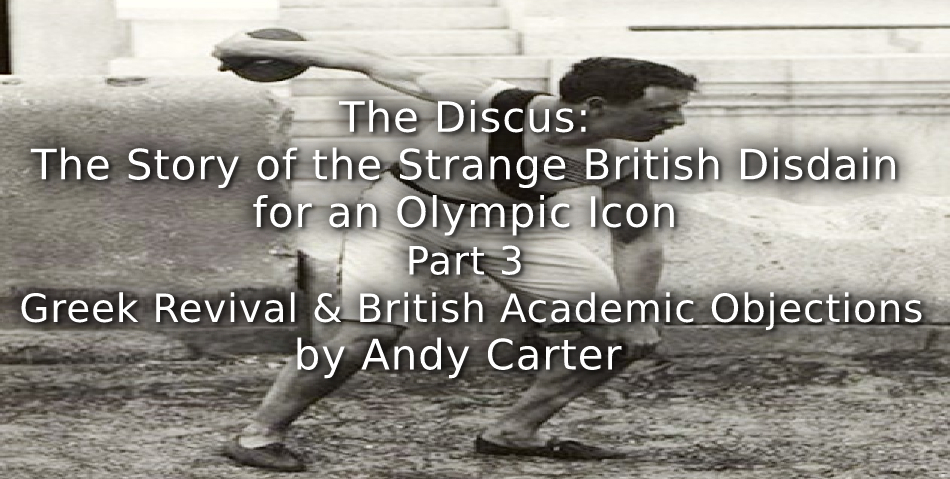To read Part 1: Classical Origins – Click HERE
and for Part 2: Early British Interest (and Disinterest!) in the Discus Click HERE
The Greeks had enthusiastically taken to the discus during the nineteenth-century. As an identifiably Greek event it was seen as a useful way to project a sense of national identity at a time when Greece was finding its way as a comparatively newly independent nation. However, after a fifteen-hundred-year hiatus, there was a problem; it was neither clear how the discus had been thrown in antiquity, or how victory was ascertained. Consequently, when the discus was revived for Evangeline Zappas’ Olympic Games of 1859 there were two events, one for distance, the other for height.
Modern Greeks may have had little idea of how best to throw the discus, but the historians of ancient sport had no clear idea either. The only thing they were agreed on was that modern throwers were getting it wrong. Mahaffy had taken exception to the athletes of 1875 using a wooden discus, but when he came to write his paper on Old Greek Athletics in 1877, he had very little to say about the discus himself. He said it was mainly thrown to test distance and he assumed, because of his interpretation of the position of Myron’s discobolus, that it was always thrown from a static position.
Mahaffy admitted that he did not know the average size or weight of an ancient discus, nor how far an athlete might have been expected to be able to throw one, although he did say that he knew of a bronze example from Aegina that was 8 inches in diameter and just under 4 pounds (1.8 kilos) in weight. He also mentioned that Philostratus had described 100 cubits as a good throw, but was sceptical of the quote’s validity. 100 cubits is about 45 metres, more than the 30 yards Mahaffy says the throwers at Athens managed in 1875, but not perhaps an unreasonable distance for somebody who had been perfecting their technique for many years.
Mahaffy set a precedent for other historians’ attitudes to the discus, as indeed he did for their attitudes towards ancient athletics in general. His assumption that the discus must be thrown from a static position seems particularly odd, given that Myron’s reputation as a sculptor was built on his ability to convey movement, but it was evidently shared by early modern Greek throwers, who developed a technique whereby the arms moved and the athlete twisted from the waist, but the feet stayed still.

Percy Gardner
Following on from Mahaffy, Cambridge Professor of Archaeology, Percy Gardner, came up with some different figures for the discus, which seemed to suggest it was a more heavyweight event. He cited a quote about the ancient athlete Phayllus which suggested that 95 feet (28.95 metres) was an exceptional throw. Gardner also suggested that a discus in the British Museum weighing 11 pounds 9 ounces (5.2 kilos) was a working specimen. Gardner dismissed other, lighter, examples of the discus as ‘probably only votive offerings’ and followed Mahaffy’s lead in interpreting the discobolus as showing that all the effort in throwing was achieved from the waist up.
In 1880 and 1882, a German schoolteacher, Christian Georg Kohlrausch, published articles on throwing the discus based on experiments he had carried out at his school in Magdeburg. Kohlrausch examined various sculptures in an attempt to work out a sequence of movement and ascertain how ancient athletes may have thrown. He then asked his students to try out the techniques and claimed to have successfully recreated the ancient technique. Unfortunately, whatever advances Kohlrausch made for German discus throwing, were lost or forgotten by the time of the 1896 Athens Olympics. Only one, unnamed, German took part, and he finished in joint last place.
By now the Greeks had over thirty years’ experience of their revived version of the discus under their belts and were confident of a clean sweep of the medals, not least because the majority of the other competitors were, like Robertson, new to the discipline, having arrived in Athens hoping to take part in a non-existent hammer throwing event. The Greeks looked to have the competition wrapped up, few of the foreign competitors having managed to even register a mark, when the American Robert Garrett, snatched victory by throwing 20 centimetres more on his last throw. Garrett had managed to throw that little bit farther by pivoting around on one leg as he threw, giving him an advantage over the Greeks who had steadfastly kept their feet still.

Robert Garrett shortly after winning the 1896 Olympic Discus title
After his victory, Garrett was asked to pose in mid-throw for a photograph that became one of the iconic images of the first modern Olympics. It is often reported that Garrett’s achievement was all the more remarkable because he had no previous experience of the discus, and his decision to enter was a last-minute whim, but this is not quite the case. Garrett was a student at Princeton, where he was captain of the track and field team. He specialised in shot put, long jump and high jump, and was to win gold in the first and silver for both of the latter in Athens as well. His history professor was William Sloane, who also happened to be the American representative on the International Olympic Committee, and it was he who suggested to Garrett that he also entered the discus. Sloane went further and had a discus made for Garrett to practice with. Unfortunately, Sloane had read Percy Gardner’s paper on the pentathlon and the discus proved too heavy and unwieldy to throw. Garrett decided that taking part would be futile. However, he was pleasantly surprised on arriving in Athens to find the Olympic discus was less than a fifth of the weight of Sloane’s version, leading him to reconsider his entry.
By the time of the 1900 Paris Olympics, techniques had changed again and the leading competitors were throwing about 10 metres more than in Athens. This breakthrough had come about after a Bohemian athlete, František Janda-Suk, improved on Garrett’s half turn of the body by introducing complete rotations, similar to those used by hammer throwers. Janda-Suk reached his conclusion after studying the discobolus and deciding that it represented a phase in a series of rotations rather than a static throw.
Article © of Andy Carter
To read Part 4: Norman Gardiner and the Dual Discus Event Olympics of 1906 and 1908 – Click HERE





